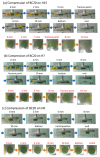Compression Test of Soft Food Gels Using a Soft Machine with an Artificial Tongue
- PMID: 31146449
- PMCID: PMC6616464
- DOI: 10.3390/foods8060182
Compression Test of Soft Food Gels Using a Soft Machine with an Artificial Tongue
Abstract
Care food is increasingly required in the advanced-aged society. Mechanical properties of such foods must be modified such that the foods are easily broken by the tongue without chewing. When foods are compressed between the tongue and the hard palate, the tongue deforms considerably, and only soft foods are broken. To simulate tongue compression of soft foods, artificial tongues with stiffness similar to that of the human tongue were created using clear soft materials. Model soft gels were prepared using gellan gums. A piece of gel on an artificial tongue was compressed using a texture analyzer. The deformation profile during the compression test was obtained using a video capture system. The soft machine equipped a soft artificial tongue sometimes fractured food gels unlike hard machine, which always fracture gels. The fracture properties measured using the soft machine were better than those obtained from a conventional test between hard plates to mimic natural oral processing in humans. The fracture force on foods measured using this soft machine may prove useful for the evaluation of food texture that can be mashed using the tongue.
Keywords: artificial tongue; care food; compression test; fracture; gellan gum gels; soft machine; texture.
Conflict of interest statement
The authors declare no conflict of interest.
Figures




References
-
- Annual Report on the Aging Society: 2017 (Summary) [(accessed on 28 February 2019)]; Available online: https://www8.cao.go.jp/kourei/english/annualreport/2017/2017pdf_e.html.
-
- Efforts relating to “Smile Care Food”. [(accessed on 28 February 2019)]; Available online: http://www.maff.go.jp/e/policies/food_ind/attach/pdf/index-9.pdf.
Grants and funding
LinkOut - more resources
Full Text Sources

